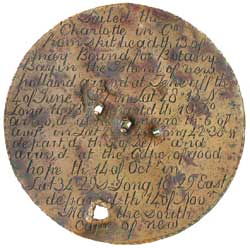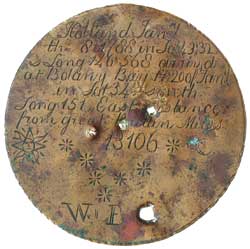Aust. Historical Medals
Lot 740 Session 3 (2:30pm Tuesday) Aust. Historical Medals
Estimate $500,000
Bid at live.noble.com.au
CHARLOTTE MEDAL, undated (1788), in copper (47mm; weight 10.5g) (C.1788/2)), engraved on both sides of a thin, crude copper disc, obverse engraved in cursive script, 'Sailed the / Charlotte in Co / from Spit head th 13 of / May Bound for Botany / Bay in the Island of new / holland arriv,d at Teneriff th / 4 of June 1787 in Lat 28"13N / Long 16"23 (holed) depart,d th 10 Do / arriv,d at Rio de Janeiro th 6 of / Augt in Lat 22"54S Long 42"38 W / depart,d th 5 of sepr and / arriv,d at the Cape of good / hope the 14 of Octr in / Lat 34"29S Long 18"29 East / depart,d the 14 of Novr / Made the south / Cape of new' and continues on reverse, 'Holland Jany / th 8 o(1 over f)788 in Lat 43'32 / s Long 146"56E arriv,d / at Botany Bay th 20 of Jany / in Lat 34 South / Long 151 East distance / from great Britain Miles / 13106', reverse also decorated with sun, crescent moon and stars, below is signed W.B. (William Broughton - see footnote). Contemporary in style this medal was engraved by Thomas Barrett one of the convicts on board the first fleet ship, Charlotte, whilst she was anchored in Botany Bay between the 20th and 26th January, 1788. The medal and its silver counterpart are regarded as the first Australian Colonial works of art and icons of the foundation of our nation and as such are of immense historical interest to Australia. Holed in four places and several dents, otherwise good fine and unique.
Ex Ian M.L.Armstrong OAM Collection and previously from Spink Australia Sale 7, 11 March 1982 (lot 438) and Christie, Manson & Woods Ltd, Melbourne Sale in 1983.
The Charlotte was one of the six convict transport ships of the First Fleet. It had a complement of crew, marines (one captain, two lieutenants, two sergeants, three corporals, one drummer and thirty five privates) and convicts (eighty nine male and twenty female). The master was Captain Thomas Gilbert, and the Surgeon, John White who was later to be appointed the first Chief Surgeon of the Colony.
The First Fleet weighed anchor on 13th May, 1787, at the Motherbank in the Channel. And on its long voyage made stops at Teneriffe in The Canaries, Rio de Janeiro, and Cape Town before beginning the final leg of the voyage to Australia. The various ships arrived at Botany Bay from 18th to 20th January, 1788, with the Charlotte arriving on the latter date. The Fleet Commander, Captain Arthur Phillip, came ashore and decided that the location was unsuitable so after a six day period the Fleet was moved to Port Jackson on 26th January, 1788.
In early May, 1788 Charlotte under charter to The East India Company, sailed for China from whence she shipped a cargo of tea to England. She was then sold to a firm of London merchants, Bond & Co. and began the next stage of her career, the London to Jamaica run. Charlotte ended her career under the ownership of John Jones, a merchant in Quebec, Canada. In 1818 she was lost off Newfoundland.
In an article by Dr John M.Chapman, The Solution of the Charlotte Enigma, in the Journal of the Numismatic Association of Australia, Vol 9, pp 28-33, he gives a resolution to the mystery surrounding the copper Charlotte Medal that appeared for sale at Spink Australia's Auction in Sydney on 11 March 1982 (lot 438). It was discovered in the 1940s during a house renovation at Camden Town, New South Wales in the area where one William Broughton had a farm called Lachlan Vale.
To trace the copper medal one must return to the Charlotte's arrival. The ship's doctor, Surgeon John White, was a keen sketcher (Source: Marine Captain Watkin Tench, A Complete Account of Settlement at Port Jackson, London, 1793) and a collector of information as well as being a doctor. This is evidenced by the fact that he collected scores of specimens of flora and fauna during his early days in the colony and then sent back to England numerous engravings of plants, birds and animals for documentation in a book. Therefore it is logical that he would request that a memento be prepared to document such an important event as the arrival at Botany Bay. Hence he commissioned the silver Charlotte Medal created by Thomas Barrett. Barrett was known by White to be an adept engraver as he had already been caught out forging coins in company with some accomplices while the Charlotte was sailing between Teneriffe and Rio de Janeiro. White even recorded in his journal, 'The impression, milling, character, in a word, the whole was so inimitably executed that had their metal been a little better the fraud, I am convinced would have passed undetected.'
As Barrett was the only known engraver on board it would be natural for White to have him create the medal. But an important question is how did a convict get all the technical data recorded on the medal? Obviously it was supplied by someone, namely Surgeon John White, and he would also have supplied the silver disc, and the scalpel for engraving. During the six day waiting period from arrival at Botany Bay until disembarking at Port Jackson White's instructions would have been delivered by his personal servant on the voyage and that person was none other than William Broughton (WB). Dr Chapman surmises that Broughton has asked Barrett to create an abbreviated version of the Charlotte Medal for him in copper.
As Dr Chapman deduces, 'When transcribing from the silver medal to the copper piece, Barrett misread the date of Departing the Cape of Good Hope as 14 Nov, instead of the correct 13 Nov. (Possibly confusing it with the arrival date, 14 Oct. on the previous line). This mistake confirms that the copper piece was derived from the silver specimen.'
A month after arrival, Thomas Barrett, the engraver of both Charlotte Medals, was tried for stealing provisions and was hanged. So, not only was he the creator of the first medals in Australia he holds the dubious honour or should it be dishonour of being the first convict to be hanged in Australia.
The silver Charlotte Medal belonging to Surgeon John White, who returned to England, remained unknown until it appeared in the famous collection of the Marquess of Milford Haven, and is published in his catalogue of British Naval Medals published in 1919 (p465, No.49). Sotheby, Wilkinson & Hodge sold it on behalf of the Marquess in the same year to A.H.Baldwin of the London numismatic firm of Baldwin and Sons. Later it was sold to John J. Ford, a renowned American coin dealer. It was then acquired by Dr John Chapman when it was in Spink Australia's, Sydney sale in November, 1981 (lot 438). He disposed of it when he sold his outstanding collection in Noble Numismatics Sale 88 (lot 704) held in Melbourne in July, 2008 where it was purchased by the Australian National Maritime Museum and as it is such an important piece of Australian history it will never be sold.
The copper Charlotte Medal discovered at Camden has made its way from the ship to shore with William Broughton. He remained in Australia and in 1789 was appointed government storekeeper in Parramatta. In 1795 he was granted land which he named Chatham Farm. He transferred to Norfolk Island in 1800 and in 1805 was appointed Deputy Commissary in New South Wales. He had five children in an unmarried relationship with Elizabeth Hearthorn and in 1809 she and their youngest child, Betsey, sailed for England in the Boyd but unfortunately when it stopped en route at New Zealand she and most of the passengers were massacred however Betsey was unharmed. In 1809 William was appointed as a magistrate and in 1810 he married Elizabeth Charlotte Simpson a widow with whom he had five children. In 1811 he received a grant of 1,000 acres at Appin and established his family farm known as Lachlan Vale. He was promoted to Acting Assistant Commissary General in 1814 and was regarded as a trusted official in Governor Macquarie's government.
William Broughton died in 1821 at the age of 53. His wife Elizabeth remained at their farm until her death in 1843. Her daughter Elizabeth Broughton who had married in June 1839 also lived there with her husband, James Garland, until about 1855 when he moved to Sydney for a business arrangement. As Dr Chapman notes in his article, 'This farm provides the final piece of the Charlotte puzzle, as it is in this very area that the copper relic was stated to have been found in the 1940s. At some stage William Broughton had his initials scored on his souvenir, and the crude perforations of the metal suggest its probable use as a marker of some description at the farm, Lachlan Vale.' The fact that William Broughton had a farm in the very same area where the medal was found in the 1940s defies the odds of just being a coincidence and only reinforces the fact that the letters 'WB' indeed stand for William Broughton.
If the silver Charlotte Medal is one of the most significant and rare items associated with the First Fleet then the copper Charlotte Medal must rank as equal in rarity and significance and it also has a direct link to a person who had such a distinguished government career after arriving in the colonies.
(References: Hawkins, J.B., Nineteenth Century Australian Silver, Woodbridge 1990, Vol 1, p31, plate 3; article by Dr John M.Chapman, The Solution of the Charlotte Enigma, in the Journal of the Numismatic Association of Australia, Vol 9, pp 28-33; Signals Number 84 September - November 1984, journal of Australian Maritime Museum, article by Curator, Kieran Hosty, pp11-15.)
With research.
Estimate / sale price does not include buyer's premium (currently 22% including GST) which is added to hammer price. All bids are executed on the understanding that the Terms & Conditions of sale have been read and accepted. For information on grading and estimates please refer to the Buying at Auction advice.
Quick find
View a lot by number and sale.
Adjacent lots
Lot 738
CAPTAIN JAMES COOK, memorial medal, (1784), in bronze (43mm) by L.Pingo for the Royal Society ...
Estimate $1,500
Lot 739
CAPTAIN JAMES COOK, memorial medal, (1784), in bronze (43mm) by L.Pingo for the Royal Society ...
Estimate $1,000
Lot 740 This lot
CHARLOTTE MEDAL, undated (1788), in copper (47mm; weight 10.5g) (C.1788/2)), engraved on both sides of ...
Estimate $500,000
Lot 741
CONVICT TOKENS, Great Britain, George III, cartwheel twopence, 1797, obverse impressed with details, 'Tom/Taylor', and ...
Estimate $100
Lot 742
CESSATION OF TRANSPORTATION, 1853, in white metal (56mm) by the Royal Mint (C.1853/2). Nearly extremely ...
Estimate $150

